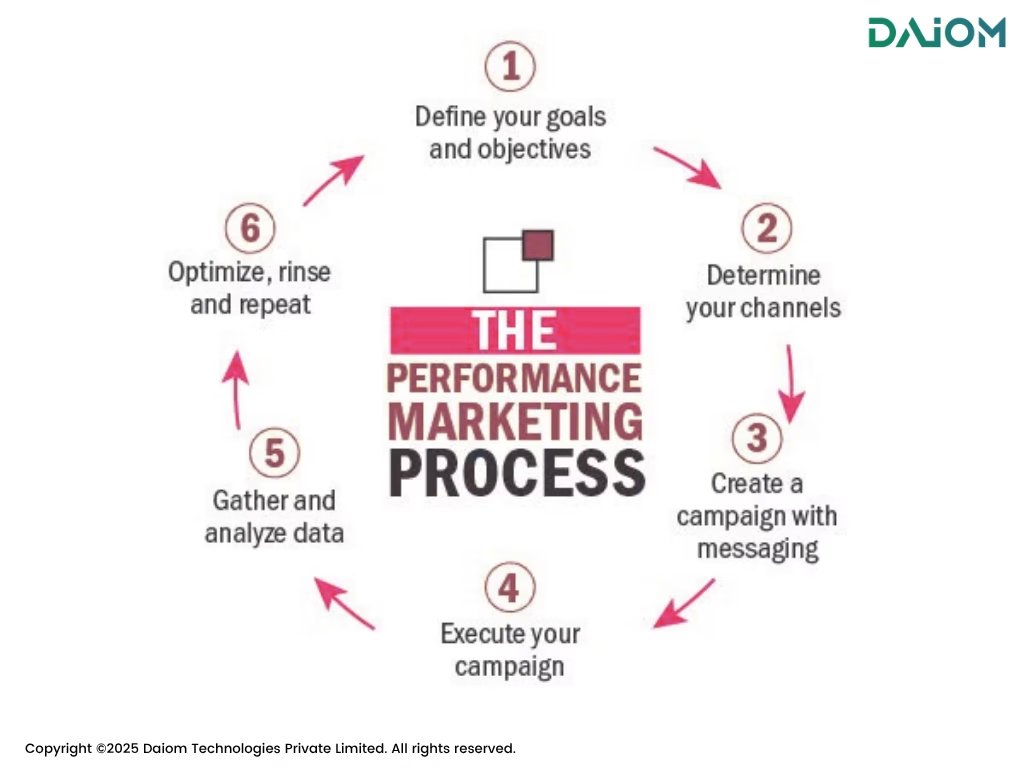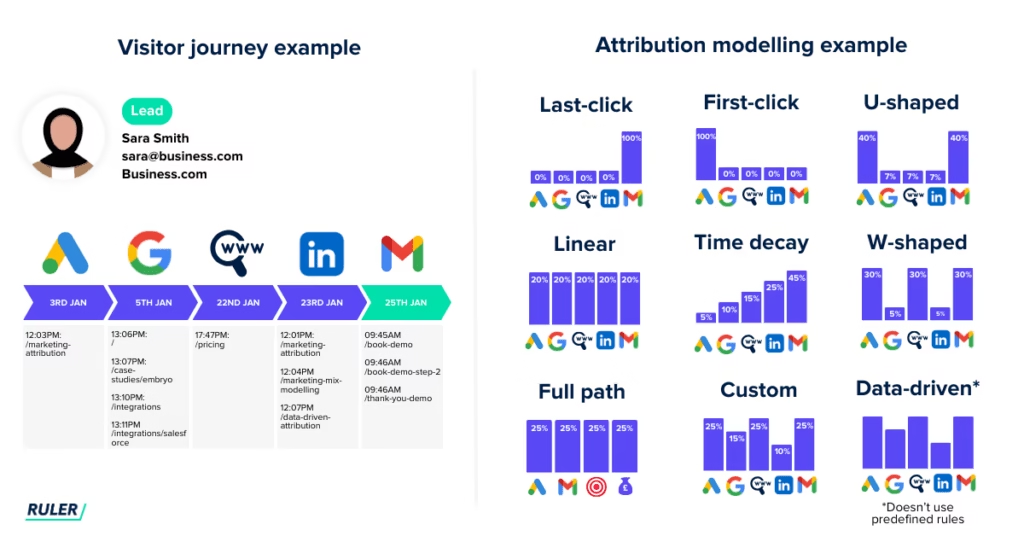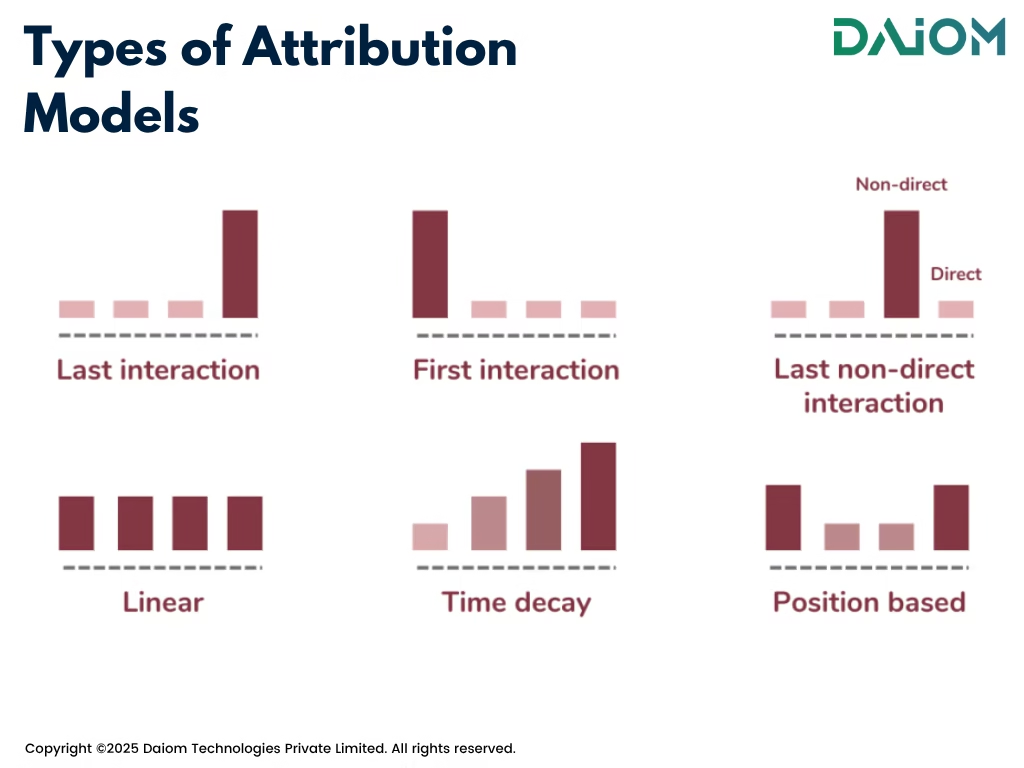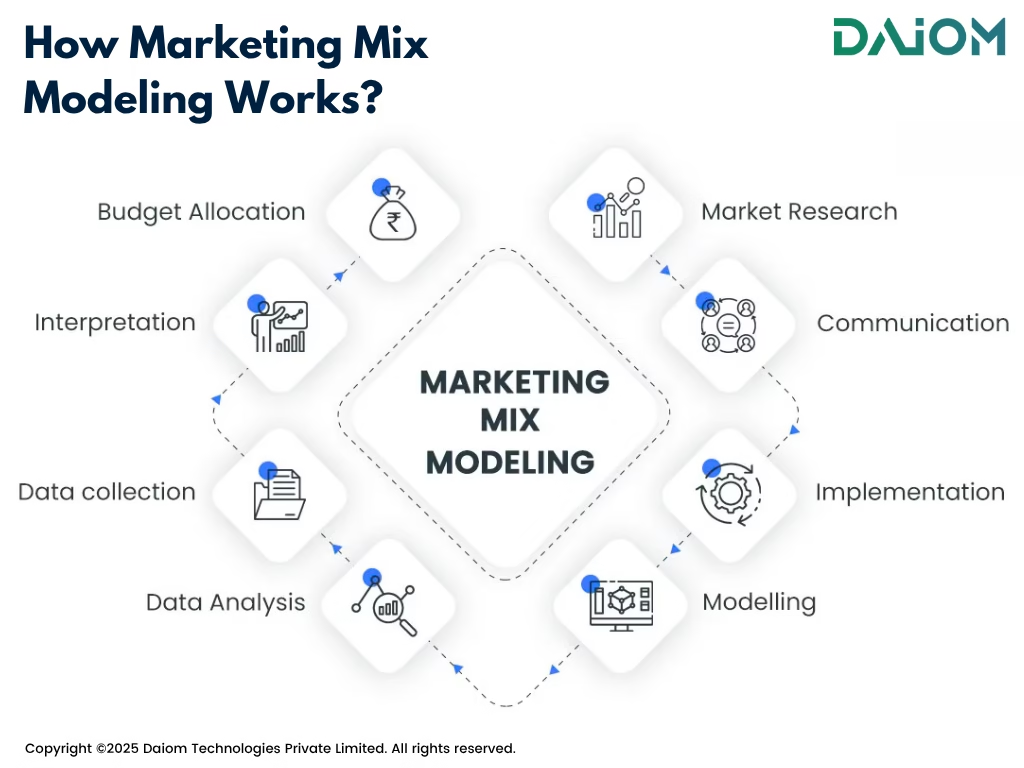Marketing is getting tougher today. If you’re part of an omnichannel brand, you’ve probably felt it—rising customer acquisition costs, too many channels to track, and constant pressure to prove what’s really working.
- Customer acquisition costs have jumped by over 60% in the last five years.
- Shoppers now interact with brands across 6+ touchpoints on average before making a purchase.
- Yet, 76% of marketers say they struggle to measure marketing ROI effectively.
With so many marketing touchpoints (online and offline), figuring out what’s actually driving sales can feel like solving a puzzle with missing pieces.
In this blog, we’ll walk through the evolution of marketing measurement—from basic digital attribution to advanced marketing mix modeling (MMM). You’ll learn how brands are navigating this complex terrain and get actionable tips to make smarter, data-backed decisions.
Marketing is no longer about the stuff that you make but the stories you tell.
Seth Godin, Author & Marketing Expert
Table of Contents
- How Is the Omnichannel Marketing Landscape Evolving?
- The Rising Challenge of Marketing Efficiency
- How Does Attribution Modeling Help You Understand Digital Marketing Performance?
- Marketing Mix Modeling: The Comprehensive Solution
- The Evolution of MMM: From Complex to Accessible
- Which Brands Should Adopt Marketing Mix Modeling?
- End-to-End Guide to Implementing MMM for Your Brand
- Conclusion
1. How Is the Omnichannel Marketing Landscape Evolving?
Omnichannel marketing means giving customers a smooth and connected experience across all channels. Unlike multichannel marketing, where each channel works on its own, omnichannel connects them all so customers get the same experience no matter where they interact with your brand.
1.1 Types of Marketing in the Omnichannel World
Omnichannel brands usually use two main ways to market their products, often at the same time:
Brand Marketing: This is about making people know and like the brand over time. It helps create a good image and a connection with customers. Brand marketing uses things like TV ads, newspaper ads, sponsoring events, and social media stories that tell the brand’s story.

Performance Marketing: This is more about getting quick, clear results using data. It focuses on actions like clicking ads, buying something, or signing up. This includes things like online ads where you pay for clicks, working with partners to promote products, search engine ads, and email campaigns to get people to take action.

The table below highlights key differences between these approaches:
Aspect | Performance Marketing | Brand Marketing |
Objective | Drives immediate sales or conversions | Builds brand awareness and long-term loyalty |
Focus | Direct response and measurable outcomes | Emotional connection and brand perception |
Metrics | CTR, conversions, ROAS | Brand awareness, engagement, brand equity |
Timeframe | Short-term, results-focused | Long-term, relationship-focused |
ROI Measurement | Immediate and quantifiable | Indirect and measured over longer periods |
2. The Rising Challenge of Marketing Efficiency
The need to get marketing measurement right is more urgent than ever because of a few big reasons:
- Rising Customer Acquisition Costs: Advertising on platforms like Facebook, Instagram, Google, and LinkedIn has become much more expensive.
- Tracking Is Less Accurate: Privacy rules and updates like Apple’s iOS changes make it harder to track who buys what after seeing an ad.
- Lower Quality Audience Data: Limits on third-party data mean it’s tougher to target the right customers, which also raises costs.
Because of these challenges, omnichannel brands must measure marketing results well across all channels—both online and offline—to spend their budgets in the smartest way.
3. How Does Attribution Modeling Help You Understand Digital Marketing Performance?
Attribution modeling is a way for marketers to figure out which steps or ads helped a customer buy something online. It looks at all the points a customer touches—like ads, emails, or social media—before they make a purchase. Then, it gives credit to each step based on how much it helped in making the sale.
Read more – Mastering Marketing Attribution: A Guide to Optimizing Your Campaigns

3.1 Types of Attribution Models

3.2 Single-Touch Attribution Models
- First-Touch Attribution: Gives 100% credit to the first interaction a customer has with your brand. Useful for understanding which channels are effective for customer acquisition and top-of-funnel awareness.
- Last-Touch Attribution: Assigns all credit to the final touchpoint before conversion. This model (commonly the default in tools like Google Analytics) helps identify which channels are most effective at closing sales.
3.3 Multi-Touch Attribution Models
- Linear Attribution: Distributes credit equally across all touchpoints in the customer journey. Every interaction receives the same weight regardless of when it occurred.
- Time Decay Attribution: Gives more credit to touchpoints closer to the conversion, assuming recent interactions have more influence than earlier ones.
- Position-Based (U-Shaped) Attribution: Assigns 40% credit to both the first and last touchpoints, with the remaining 20% distributed among middle interactions. This acknowledges the importance of both discovery and decision-making moments.
3.4 The Purpose and Value of Attribution Modeling
Attribution modeling helps digital marketers in many important ways:
- Know which channels work best: It shows which ads or platforms help customers buy at different steps.
- Use budget wisely: It helps put money into the ads that bring the best results.
- Improve campaigns: It gives ideas on how to make ads better by understanding how customers respond.
- Measure profits better: It helps figure out the real return on money spent on marketing.
Attribution works best for online marketing channels where we can track what users do, like paid search ads, display ads, emails, and social media posts.
3.5 The Limitations of Attribution in an Omnichannel World
Despite its value for digital marketing optimization, attribution modeling falls short in several critical ways when applied to the broader omnichannel marketing environment.
- Misses Offline Actions: Standard attribution doesn’t count offline steps like store visits, billboards, TV ads, or word-of-mouth.
- Unclear Credit: It often gives credit to touchpoints without solid data, choosing first-click or last-click just by guesswork.
- Ignore Time Gaps: It doesn’t consider how much time passes between customer interactions, which can affect their impact.
- Treats All Interactions the Same: It doesn’t tell the difference between quick views and deep engagement.
- Only Looks at Wins: It studies only successful sales, missing what doesn’t work.
For omnichannel brands, this causes problems, like missing how online research leads to in-store buying or how TV ads help online sales.
4. Marketing Mix Modeling: The Comprehensive Solution
To overcome the limitations of attribution in an omnichannel environment, forward-thinking brands are turning to an approach called Marketing Mix Modeling (MMM).

4.1 What is Marketing Mix Modeling?
Marketing Mix Modeling (MMM) is a way to use statistics to see how different marketing efforts—both online and offline—help sales and business goals. Unlike attribution, which looks at individual customers, MMM looks at overall data from all customers together.
MMM has been around for many years but is becoming popular again because of better data tools and more complex marketing. It helps businesses understand how all their marketing actions work together to drive results.
4.2 How Marketing Mix Modeling Works?
MMM uses simple math to see how marketing efforts (like money spent on ads) affect results (like sales). Here’s how it usually works:

- Collect Data: Gather past data on:
- Money spent on marketing (online ads, TV, print, radio, etc.)
- Sales or revenue for the same time
- Other things that affect sales (like seasons, economy, competitors)
- Organize Data: Sort the data into two groups:
- What you want to predict (usually sales)
- What affects sales (marketing and other factors)
- Analyze Data: Use math (called regression) to find how marketing affects sales.
- Check the Model: Test the results with old data to make sure it works well.
- Understand Results: Learn which marketing channels help sales the most.
- Plan Budget: Use these insights to spend marketing money smarter across channels.
4.3 A Simplified MMM Example
A clothing store that sells both online and in physical shops wants to know which marketing helps sell the most.
Data collected:
- How much money they spent each month on TV, print ads, social media, search ads, and emails
- Sales numbers for the last two years
- Seasonal events and sales promotions
Analysis:
They use math to see how spending on each channel affects sales, while keeping in mind seasons and promotions.
Results might show:
- Every $1 spent on TV ads brings $3 in sales over three months
- Every $1 spent on social media brings $2 in sales within one month
- Every $1 spent on search ads brings $4 in sales right away
- Print ads work well during holidays but not much at other times
What they do next: The store may spend less on print ads outside holidays, keep spending on search ads to get quick sales, and use social media for fast sales boosts.
5. The Evolution of MMM: From Complex to Accessible
Marketing Mix Modeling has undergone significant evolution over the decades, becoming increasingly sophisticated yet paradoxically more accessible to brands of all sizes.

5.1 From Agency Exclusivity to Democratized Access
Historically, MMM was the domain of large enterprises with substantial budgets who could afford specialized agencies and data scientists. The process was time-consuming, expensive, and often resulted in insights that were outdated by the time they were delivered. Recent advancements in data science, computing power, and automated platforms have democratized access to MMM techniques, making them available to a broader range of brands.
5.2 Google Meridian: Making MMM Accessible
In March 2024, Google launched Meridian, an open-source Media Mix Modeling platform that represents a significant step toward making advanced marketing measurement accessible to more brands.

Key features of Google Meridian include:
- Bayesian Regression: Uses Bayesian statistical methods to quantify uncertainty associated with advertising contributions, allowing for more nuanced decision-making even with limited data.
- Geo-based Hierarchical Modeling: Incorporates geo-level advertising data to extract more detailed insights than national-level data alone can provide.
- Cookieless Measurement: Works without relying on individual user tracking, making it compliant with evolving privacy regulations.
- Open-Source Approach: As an open-source tool, Meridian allows for customization and community-driven improvements over time.
Google Meridian helps marketers answer three fundamental questions:
- How are my advertising channels contributing to key performance indicators?
- What was my return on advertising spend (ROAS)?
- How can I optimize my budget allocation to maximize ROAS?
6. Which Brands Should Adopt Marketing Mix Modeling?
While MMM is becoming more accessible, it’s particularly valuable for certain types of brands:
- Brands with Significant Marketing Budgets: Companies investing at least $1 million annually in marketing across multiple channels can gain substantial value from the optimization insights MMM provides.
- Omnichannel Retailers: Businesses with both digital and physical presence benefit most from MMM’s ability to measure cross-channel effects.
- Brands Focused on Long-term Growth: Organizations that invest in brand building alongside performance marketing need MMM to understand the full impact of these investments.
- Data-Rich Organizations: Companies with at least 2-3 years of historical marketing and sales data will get the most accurate results from MMM analysis.
- Brands in Competitive Markets: Businesses facing intense competition and rising acquisition costs need the efficiency gains MMM can deliver.
7. End-to-End Guide to Implementing MMM for Your Brand
Ready to implement Marketing Mix Modeling for your omnichannel brand? Here’s a step-by-step approach to get started:
7.1. Prepare Your Data Foundation
Identify Key Marketing Channels: Make a comprehensive list of all marketing channels your brand uses, including:
- Paid digital (search, social, display, video)
- Organic digital (SEO, organic social)
- Traditional media (TV, radio, print, out-of-home)
- Email and direct mail
- In-store promotions and events
Collect Historical Spending Data: Gather detailed information on marketing expenditures by channel over time (ideally weekly or monthly data for at least two years).
Compile Business Performance Data: Collect corresponding sales or conversion data that aligns with your marketing spend timeframes.
Consider External Factors: Identify factors that might influence sales independent of marketing, such as:
- Seasonality patterns
- Competitor activities
- Economic indicators
- Weather events (if relevant)
- Price changes and promotions
7.2. Choose Your MMM Approach
Evaluate Available Tools:
- For advanced users: Google Meridian’s open-source platform
- For less technical teams: Consider third-party MMM solutions or consulting partners
Determine Resource Requirements:
- Technical expertise needed
- Time investment required
- Budget for tools or external support
7.3. Build Your Initial Model
Define Model Parameters:
- Select the appropriate time granularity (weekly/monthly)
- Determine lag effects (how long marketing takes to impact sales)
- Identify diminishing returns thresholds
Run Initial Analysis:
- Import your prepared data into your chosen MMM platform
- Configure model settings
- Execute the analysis
Validate Results:
- Compare model predictions against actual historical performance
- Adjust parameters as needed to improve accuracy
- Conduct sensitivity analysis to test stability
7.4. Extract Actionable Insights
Measure Channel Effectiveness:
- Identify the Return on Ad Spend (ROAS) for each marketing channel
- Determine the optimal spending level for each channel before diminishing returns
Understand Interaction Effects:
- Analyze how channels work together (synergies)
- Identify cannibalization where channels compete
Quantify Base Sales vs. Incremental Sales:
- Determine what portion of sales would occur without marketing
- Calculate the true incremental impact of marketing activities
Project Future Scenarios:
- Create “what-if” analyses for different budget allocations
- Forecast expected outcomes from strategy changes
7.5. Implement and Iterate
Optimize Budget Allocation:
- Redistribute marketing investments based on model insights
- Set appropriate expectations for performance changes
Establish Ongoing Measurement:
- Update your model with new data regularly
- Track actual performance against model predictions
Refine Your Approach:
- Incorporate new marketing channels as they emerge
- Adjust for changes in consumer behavior or market conditions
7.6. Using Google Meridian Effectively
If you choose to use Google’s open-source Meridian platform, here are specific tips for success:
Start with Proper Data Preparation:
- Organize your data according to Meridian’s required format
- Ensure consistent time periods across all datasets
Leverage Bayesian Capabilities:
- Use Meridian’s Bayesian regression features to account for uncertainty
- Incorporate prior knowledge where appropriate
Utilize Geo-Based Analysis:
- If you have regional data, take advantage of Meridian’s hierarchical modeling
- Compare performance across different markets
Interpret Results Thoughtfully:
- Focus on confidence intervals, not just point estimates
- Look for consistent patterns rather than overreacting to small variations
8. Conclusion
Marketing is getting more complex. So, brands that sell on many channels need smarter ways to measure what’s working.
Attribution models help track digital campaigns. But to see the full picture across all channels, Marketing Mix Modeling (MMM) is better. Now, tools like Google Meridian are making MMM easier for everyone to use. This helps brands make smarter, data-backed decisions.
By using both – attribution for details and MMM for the big picture – brands can grow faster and build stronger relationships with customers. With rising costs and more competition, this kind of smart measurement isn’t optional anymore. It’s a must for long-term success.
Also read – The Ultimate App Attribution Guide for Your Digital Marketing Success
If you’d like to discuss how we can assist with marketing attribution and optimize your marketing strategies, we’re happy to set up a consultation call. Feel free to reach out to us at alibha@daiom.in.
For more insights and updates on the latest MarTech trends, follow DAiOM!
Subscribe to our Newsletter!


